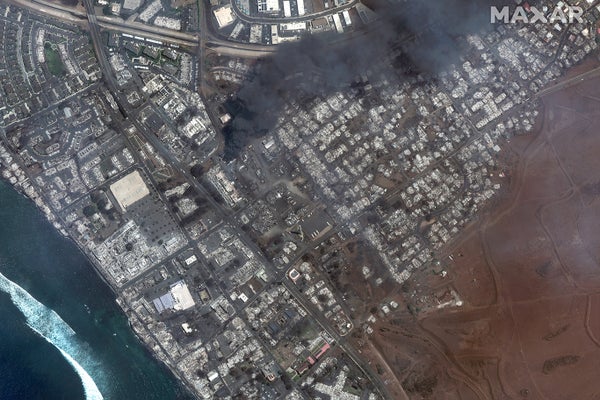Editor’s Note (9/22/23): This story has been updated with information about the latest death toll. Maui officials announced on Sept. 15 that the number of fatalities was lower than previously reported after DNA testing of remains.
At least 114 people have been confirmed to be killed by wildfires that raged uncontrolled on the famously beautiful Hawaiian island last week. People were left with little time to escape from the fast-moving flames, and a few even fled into the ocean to avoid the blaze. Officials say they expect the death toll to rise, and news reports have included accounts of people looking for missing relatives.
The fire that struck the historic town of Lahaina on the western side of Maui is now the deadliest wildfire in the U.S. in more than a century. It has eclipsed the toll from the Camp Fire, which tore through Paradise, Calif., in 2018 and killed 85 people.
On supporting science journalism
If you're enjoying this article, consider supporting our award-winning journalism by subscribing. By purchasing a subscription you are helping to ensure the future of impactful stories about the discoveries and ideas shaping our world today.
The devastating Maui fires, along with some on Hawaii’s Big Island, were the product of a confluence of weather conditions—namely, strong winds, dry vegetation and low humidity—says Robert Bohlin, a meteorologist at the National Weather Service’s (NWS’s) office in Honolulu.
The stage was set by drought conditions across various parts of the state’s islands, especially Maui. “This is the time of year when we start to dry out,” Bohlin says. That typical dryness has been exacerbated by weaker-than-normal trade winds that have kept rain away, according to the U.S. Drought Monitor. Drought dries out grasses and other vegetation, making them more likely to ignite in a wildfire.
Two other factors were a large atmospheric pattern that featured a strong high-pressure area to the north of the islands and a strong low-pressure area—in the form of Hurricane Dora—to the south. Wind tends to flow from high-pressure areas to low-pressure ones, and the stronger the pressure difference, the faster the winds. “We’re in that sweet spot between that very strong high and that very strong low,” Bohlin says. And the islands’ rugged terrain can sometimes funnel those winds and create stronger gusts. The NWS had warned of winds of 30 to 45 miles per hour, with gusts up to 60 mph.
Such strong winds can quickly spread flames. “The fire can be a mile or more from your house, but in a minute or two, it can be at your house,” said Maui County’s fire assistant chief Jeff Giesea in a recent press release from the county.
The large atmospheric patterns “also brought in some really dry air,” Bohlin says, which promotes fire growth as well.
All of these conditions make it very difficult for firefighters to beat back the flames, which can spread faster and more unpredictably. Firefighting aircraft were unable to fly because of the high winds, and firefighters have reported low water pressure in hydrants, making it difficult for them to beat back flames on the ground. The sirens the state uses to communicate tsunami warnings and other emergency information did not sound before the fire, and residents have said they did not receive evacuation orders. Cell-phone service and power were affected in the area even before the fire swept through.
The spreading flames destroyed numerous homes, historic buildings and businesses on Front Street in Lahaina. “About 80% of Lahaina is gone,” Green said last Thursday, according to CNN.
Parts of this side of the island have had no landline or cell-phone service, according to the county government. Thousands of people also have been without power. Visitors have been asked to leave Maui because of limited resources on the island. President Joe Biden has declared a major disaster for Hawaii, the National Guard has been deployed, and the Federal Emergency Management Agency is working on the ground to distribute supplies.
The fire that swept through Lahaina was 90 percent contained as of August 20. The Pulehu fire to the south was 100 percent contained, and the two fires in the middle of the southern portion of the island were both 85 percent contained.
Both state officials and insurance experts have said the economic losses are likely to reach into the billions of dollars. The U.S. already saw a record of 15 weather and climate disasters that cost at least a $1 billion each over the first seven months of the year.
